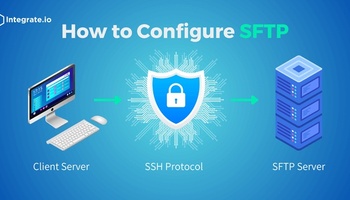- HIPAA Overview
- What Data Does HIPAA Protect?
- Who Does HIPAA Apply To?
- Challenges of Complying with HIPAA in Big Data Environments
- What Happens if You Fall Out of HIPAA Compliance
- Benefits of Using ETL Solutions for Big Data HIPAA Compliance
- Integrate.io Field-Level Encryption for HIPAA Compliance
- FAQs
The Health Insurance Portability and Accountability Act, or HIPAA, is a federal regulation in the United States that protects healthcare data containing personal health information, or PHI. It also covers Electronic PHI, or E-PHI, which are digital records of this information.
The ability to effectively using healthcare data is essential for improving patient outcomes, quality of care, resource allocation, revenues, and other operations. However, maintaining compliance with HIPAA requirements can be challenging. Extract, Transform, Load tools help streamline part of this process and empower healthcare organizations with modern, connected applications.
HIPAA Overview
One of the main goals of HIPAA data compliance was to establish best practices for collecting, storing, and transferring electronic healthcare data. The Security Rule and Breach Notification Rule provide significant guidance for implementing these practices in your organization.
What Data Does HIPAA Protect?
HIPAA doesn’t cover every single type of data that a healthcare organization works with. It specifically focuses on personal health information that can individually identify a person. HIPAA’s Privacy Rule includes all types of transmission and storage, whether it’s a hard copy, electronic, or orally relayed.
Sensitive data that HIPAA protects at covered entities and business associates include:
- Names
- Date of birth and date of death
- Dates that connect to the individual’s medical treatment or conditions
- Phone numbers
- Email addresses
- Home addresses
- Payment information
- Individual’s health conditions
- Social security numbers and other identifying numbers
- Photos
- Biometric data, such as fingerprints
- Account numbers
- Test numbers
As a general rule of thumb, if you work with health data that could identify someone in the United States, it is safer to assume that it falls under HIPAA regulations. For example, new data sources and technology, such as advances in wearables and IoT devices, may create new forms of PHI that are not already covered by the published guidelines. Even if they’re not explicitly laid out in HIPAA regulations, they are still covered.
Who Does HIPAA Apply To?
HIPAA regulations impact more than just healthcare organizations and insurance companies. Business associates of those organizations must also apply these practices to the covered data. These associates include:
- Subcontractors
- Consultants
- Software companies
- Data storage companies
The Security Rule
HIPAA establishes its expectations for data security in this rule. It is a set of relatively open-ended guidelines to encourage the adoption of new technology that improves patient care, along with being flexible and scalable for the variety of businesses covered under these regulations.
The general security requirements cover the major points for compliance:
- E-PHI that is created, maintained, transmitted, and received must be confidential and available. You also need to maintain the information’s integrity.
- Proactively identify and protect against threats that are likely to impact this data.
- Put measures in place to prevent unauthorized disclosures and impermissible uses of this information.
- Make your workforce comply with these requirements.
The Security Rule then moves into three specific categories of safeguards: administrative, physical, and technical.
Administrative safeguards include risk analysis, policies, and procedures to control information access, security management processes, a designated security official, workforce training, and periodic evaluation.
Physical safeguards include controlling access to facilities, establishing who is authorized to enter the facility, creating policies and procedures governing the use and access to workstations and devices, and how to safely remove, re-use, dispose of, and transfer media.
Technical safeguards include access, audit, and integrity controls, along with transmission security measures.
Your organization has the responsibility of fixing violations and material breaches that puts e-PHI at risk. You also need to document your security policies and procedures and maintain these records for six years after either their creation date or their last effective date. Actions, activities, and assessments relating to the Security Rule must also be maintained in this fashion.
HIPAA Breach Notification Rule
If a data breach occurs and an individual’s PHI is accessed by an unauthorized party, your company has sixty days to send a notification to each person impacted. For breaches with greater than 500 PHI records involved, you also have to send notice to the Department of Health and Human Services and send out a press release. You don’t need to send a per-incident notification to this department if your breach falls under 500 records, but you do need to create a bulk report to send annually unless you have zero breaches.
Your reports need to cover the following points:
- What PHI was accessed in the breach?
- How did the data breach happen?
- If known, who accessed or saw this information?
- Whether that person or entity actually looked at the information or if it was simply made available in the breach.
- What steps did you take to fix the breach and reduce the chance of a reoccurrence?
Challenges of Complying with HIPAA in Big Data Environments
Healthcare providers, insurance companies, and business associates use a wide range of applications for managing electronic health records, creating patient portals, running tests, entering physician orders, tracking medication, creating claims, and more. The data from these systems offer powerful insights, but maintaining HIPAA compliance with big data can be complicated.
Some of the most common challenges include:
- Masking or removing PHI as it moves between systems
- Making sure PHI is only sent to authorized users
- Protecting data from ransomware and other types of malware
- Transforming data into the proper formats for analytics tools
- Efficiently moving PHI to data warehouses and lakes
- Avoiding data loss during transfers
- Catching inaccuracies and inconsistencies in data before it reaches the data warehouse
The right combination of policies, procedures, and technology allows you to leverage your data without falling out of HIPAA compliance.
What Happens If You Fall Out of HIPAA Compliance
Your company is HIPAA compliant when it adheres to the standards, policies, procedures, and practices in this regulation. The Department of Health and Human Services' Office of Civil Rights conducts audits to determine whether you are in or out of compliance.
A lack of HIPAA compliance can quickly become costly for organizations working with PHI. The consequences vary depending on whether noncompliance occurs accidentally or if you intentionally took steps that are out of line with the rules, the scope of the problem, and how many prior violations your organization has.
Both civil and criminal penalties are on the table with HIPAA noncompliance. Fines range from $100 to $1.5 million for the civil category. If you accidentally fall out of compliance, the maximum fine is $50,000 for each incident. If the HIPAA violation happens due to willful neglect, and your organization misses the deadline to fix the problem, the fines start at $50,000.
Criminal violations are levied against the individuals in the organization involved in the incident. When someone intentionally gets access to protected data or discloses it, the maximum fine is $50,000, and up to one year in prison. Using false pretenses to get to the PHI has a higher fine and prison sentence, at $100,000 and five years in prison. The most severe penalties are those where the individual plans on selling the PHI or otherwise using it for commercial gain. The fine is up to $250,000 and the prison sentence goes up to ten years.
Benefits of Using ETL Solutions for Big Data HIPAA Compliance
Extract, Transform, Load solutions such as Integrate.io, help integrate data from disparate systems and move it into data warehouses and lakes for analytics solutions. These platforms offer many benefits for improving HIPAA compliance and interoperability such as:
- Automating sensitive data identification and encryption: ETL tools are designed to work with massive data sets, allowing you to quickly identify HIPAA-regulated data and encrypt it automatically. If you don’t need PHI included in the data set, you can filter it out before it gets to the endpoint.
- Transforming source data into the right format: The transform step of the ETL tool standardizes your data before moving it to the destination. You end up with interoperable data.
- Lowering compliance costs: An automated, cloud-based ETL solution has the hardware, software, support staff, and development team in place as part of the service offering. Working with a HIPAA-compliant ETL provider offloads some of the many expenses associated with these regulations.
- Reducing human error: Manually processing data sets can lead to errors that threaten your HIPAA compliance. Automating this part of the process limits the risk of inaccuracies and mistakes.
- Scaling PHI encryption: You can seamlessly scale your PHI encryption requirements up and down as needed.
- Speeding up the development process: Your data is cleansed as part of the ETL process and converted into the needed format. When it loads into your data warehouse, developers have immediate access to usable data.
- Preventing data loss: A consistent, standardized process for moving data from your databases and applications into your data warehouse reduces the risk of lost data.
Integrate.io Field-Level Encryption for HIPAA Compliance
Integrate.io offers field-level encryption for your data. This feature allows you to protect individual fields at the source as needed for HIPAA compliance. Our field-level encryption uses Amazon’s Key Management Service, or KMS, which allows you to set up your own encryption key so you have full control of field encryption and decryption, rotating your keys, and logging this information. It’s a simple process that gives you a powerful tool for maintaining HIPAA compliance.
After you set up a KMS key, you only need to provide Integrate.io with the ARN. Your secret does not need to be exchanged. When you set up your data pipelines with our user-friendly graphical process, you pass the ARN to the Encrypt and Decrypt components. No coding is needed, so pipeline creation for HIPAA compliant data transfer is available to a much broader user base than low or high code requirement ETL platforms.
Streamline Your HIPAA Compliance With Integrate.io
Our platform is also cloud-based, which means that our team members can’t access client data. We follow HIPAA business associate requirements so your PHI is appropriately managed throughout the ETL process, and we have many strict security protocols in place. Are you ready to make HIPAA compliance easier for your Big Data solutions? Get a 14-day demo of Integrate.io and test our security measures for yourself.
FAQs
Q: How do you implement HIPAA?
To implement HIPAA, organizations must:
-
Designate HIPAA Privacy and Security Officers to oversee compliance efforts.
-
Conduct a risk assessment to identify where protected health information (PHI) is created, received, maintained, or transmitted, and evaluate risks to its confidentiality, integrity, and availability.
-
Develop and enforce policies and procedures that comply with the HIPAA Privacy, Security, and Breach Notification Rules.
-
Implement administrative, physical, and technical safeguards to protect PHI, including access controls, device security, and data encryption.
-
Train all workforce members on HIPAA requirements and security awareness.
-
Establish processes for incident reporting, breach response, and ongoing monitoring of compliance.
-
Maintain and review Business Associate Agreements (BAAs) with vendors who handle PHI.
-
Regularly audit and update compliance measures as regulations or business practices change.
Q: What are the three main HIPAA rules?
The three main HIPAA rules are:
-
Privacy Rule: Governs the use and disclosure of individuals’ PHI, ensuring patients’ rights to privacy and access to their health information.
-
Security Rule: Sets standards for safeguarding electronic PHI (ePHI) through administrative, physical, and technical protections.
-
Breach Notification Rule: Requires covered entities to notify affected individuals, the Department of Health and Human Services (HHS), and sometimes the media, in the event of a breach involving unsecured PHI.
Q: What is the main purpose of HIPAA?
The main purposes of HIPAA are to:
-
Improve the portability and continuity of health insurance coverage for workers and their families when they change or lose jobs.
-
Combat waste, fraud, and abuse in health insurance and healthcare delivery.
-
Simplify and standardize healthcare administrative processes to improve efficiency.
-
Protect the privacy and security of patients’ health information and ensure individuals are notified if their data is breached.
Q: What is EDI and HIPAA?
EDI (Electronic Data Interchange) is the electronic exchange of standardized healthcare information between organizations, such as claims, payments, and eligibility inquiries. HIPAA requires the use of specific EDI transaction standards to streamline and secure the transmission of healthcare data, improving efficiency and reducing administrative burdens. The HIPAA EDI Rule defines the formats and data elements for these electronic transactions, ensuring consistency and privacy in healthcare communications.










